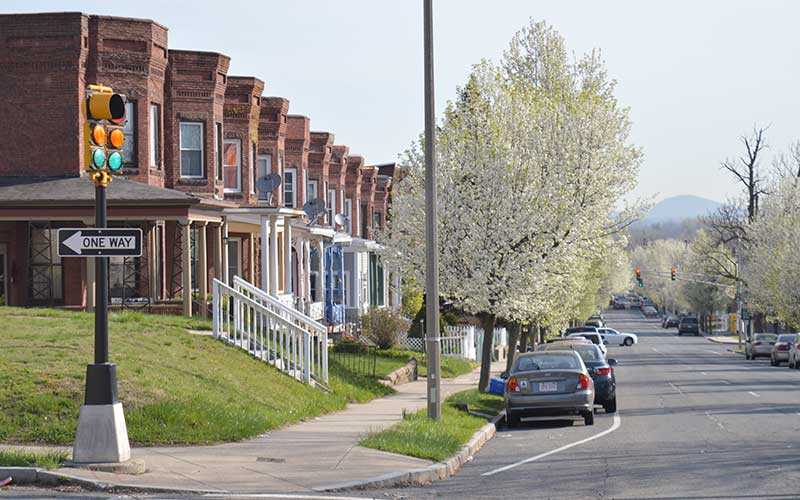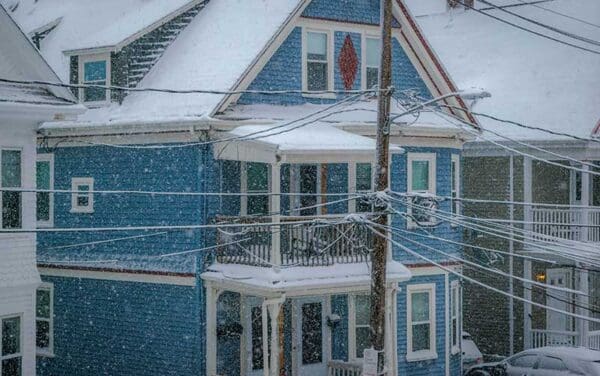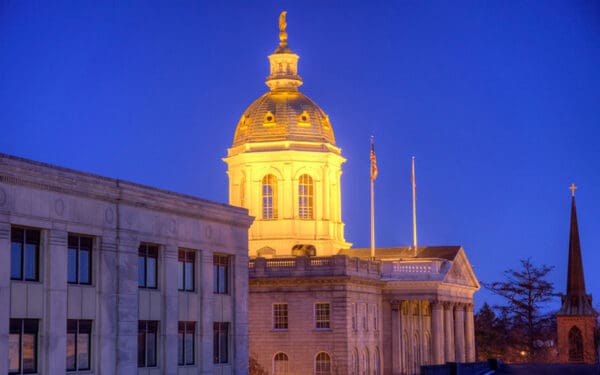
Urban forests promote better health, help cool neighborhoods during heat waves, and prevent flooding.
My family planted a Jane magnolia tree in our front yard on Earth Day. We picked this tree because it will be happy in our changing climate, it sits on our town’s “preferred tree list,” it won’t shade our roof-top solar, and my husband likes pink flowers. But despite our best efforts, it didn’t blossom like we’d expected – we probably weren’t watering it enough.
We’re not the only ones struggling to grow trees. Across New England, property owners, community organizations, and cities and towns struggle with growing and preserving the trees, shrubs, plants, and mosses that comprise our urban forests.
Given the many health and climate benefits of trees in urban areas – more to come on those below – we at CLF recently took a deep dive into strategies to help make our region’s urban forests thrive. We spoke with stakeholders, conducted research, and worked directly with communities across New England to understand the common challenges facing urban foresters and identify and test real-world solutions.
Our findings – published in this new report – provide a blueprint for accelerating efforts to grow and maintain urban forests here in New England and beyond.
Why Is the Urban Forest Important?
Research shows that trees contribute to improved physical and mental health. But they also play an increasingly important role in protecting people from the effects of climate change, including extreme heat, wildfires, and stormwater flooding.
- Health benefits: Trees filter air pollution, which means better health for those suffering from respiratory ailments (and fewer of those ailments in the first place). Researchers have even quantified those benefits at nearly $7 billion, given that less air pollution means lower healthcare costs (thanks to fewer visits to the doctor or emergency room to treat respiratory illnesses).
- Cooling benefits: Studies have found a 29°F difference in surface temperature between unshaded asphalt and asphalt shaded by tree canopy. That sun-exposed asphalt gets too hot for pets and people to walk on without wearing paw protection and shoes. That’s why having lush tree canopies in urban areas is so essential for keeping homes – as well as sidewalks, playgrounds, parks, and bike paths – cooler and safer, even during heat waves.
- Flooding benefits: Urban trees also provide an important stormwater management function. Researchers showed that, after 31 trees were removed along a 1,300-foot stretch of road, stormwater volume when it rained increased by 30%. That means when we have trees helping to filtrate rain, we get less pollution running into our waterways and less property damage when floods strike.
Here’s How We Can Preserve and Grow Our Communities’ Urban Forests
Conduct Tree Inventories (Even Partial Ones)
Urban forests provide the most benefits when they are diverse in species and age, evenly distributed across a community, and in good health. Tree inventories that record trees’ location, characteristics, and condition can help direct city resources to the most beneficial areas.
A comprehensive inventory can be costly and time-intensive to produce, but some information can be gathered quickly through satellite imagery and then built on over time. If a complete tree inventory seems too big a lift, cities can create partial inventories that prioritize data collection and planting in neighborhoods with the least tree canopy. We know that these priority areas are more likely to be lower-income neighborhoods and neighborhoods of color – due, in part, to our country’s shameful history of redlining. Prioritizing these areas first, and expanding the tree inventory over time, helps to promote tree equity in communities.
For example, in Holyoke, Massachusetts, urban foresters conducted a partial inventory in four environmental justice neighborhoods in an effort to implement its first-of-its-kind Urban Forest Equity Plan. This allowed the city to prioritize directing limited urban forest resources to areas that needed and would benefit from them the most.
Find Ways to Minimize Land Use Conflicts
In our compact New England communities, fierce competition exists for space on the ground (and below and above it). Small patches of land prime for tree planting often are already claimed by overhead electrical wires, underground utility infrastructure, parking areas, and bicycle lanes. If used for tree planting, some of these spaces would create a shade conflict with existing or planned solar panel installations.
In dealing with overhead conflicts with electric wires and solar panels, selecting smaller tree species sometimes allows both uses to co-exist. A city or town can distribute a “preferred tree list” that identifies suitable planting options for these sites. In areas with little room for these necessary uses, design and engineering solutions can add space for trees. Being intentional about where we put bike paths, sidewalks, trees, and utility lines can help preempt conflicts down the road (literally and figuratively). New technology is even available that could allow solar panels and shade trees to be located together without undermining either one’s effectiveness.
Urban Forest Funding and Strategies for Reducing Costs
Urban forestry can take a lot of time and money. Many factors contribute to the cost of planting trees: where a tree is sourced, how it is prepared for transport and delivered, the readiness of the planting site, and how the tree is planted and will be cared for. In some cases, cost-saving measures for one of these steps can increase costs elsewhere in the process. For example, sourcing a smaller bare-root tree from a local nursery could cost less for the tree itself and its delivery and planting. But it requires additional costs to care for the tree over the next several years. On the other hand, starting with larger trees that require machinery for planting can be expensive upfront but require less ongoing maintenance.
In Burlington, Vermont, the city partners with a nonprofit organization called Branch Out Burlington, which operates a local bare-root nursery. This partnership has enabled the city to radically reduce its planting costs per tree, meaning more trees are planted yearly.
There isn’t one right answer. Each for solving funding challenges. Each community must assess its funding sources, staff, and volunteer availability to determine its most economical path. Suppose a community’s funding sources cover the cost of planting trees but not their maintenance or site preparation (as is typical). In that case, the community may need to buy fewer, more expensive trees that can be maintained by a few city employees or a small group of volunteers. Making urban forestry funds more flexible could help communities buy more, less expensive trees and pay contractors to maintain them until they reach maturity, significantly increasing canopy coverage.
Thriving Urban Forests: Continuing the Conversation
This is just a snapshot of what our research uncovered. You can read more about the solutions to common urban forestry challenges.
We know that even common challenges can look a little different in individual communities. Sometimes, a community may have found a working solution we haven’t identified. In other cases, no known solution may exist. That’s why we will continue to explore opportunities to help accelerate urban forestry in New England.
Thank you to the Wells Fargo Foundation for providing the financial support to make this report possible.



